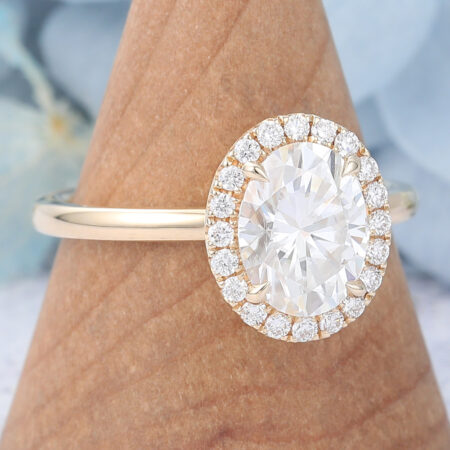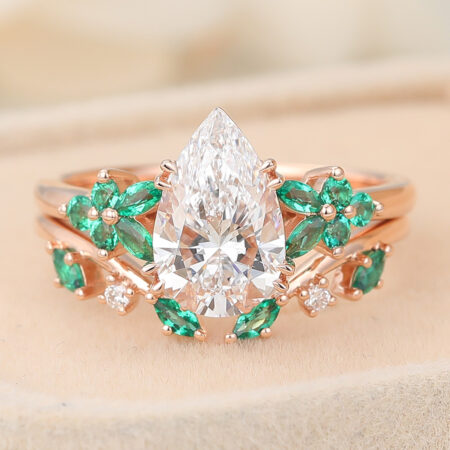What Is a Simulated Diamond? Meaning, Differences, and How to Tell It Apart
Shimmering with diamond-like beauty yet crafted differently, simulated diamonds have gained wide attention. In this guide, we define simulated gems, explain what a simulated diamond really is, and reveal how to spot the differences from natural ones.
What Is a Simulated Diamond?
Simulated diamond, also known as a diamond simulant, is a gemstone designed to mimic the appearance of a natural diamond. While it may closely resemble a real diamond in brilliance and sparkle, it is not an real diamond. Instead, it is a look-alike diamond alternative made from different materials, offering the aesthetic appeal of a diamond without its chemical composition or physical properties.
Why Are Simulated Diamonds Made?
Although it does not have the characteristics and composition of real diamonds, diamond simulant jewelry has been loved by many consumers in recent years. This is not only a trend, but also a rational choice based on the following reasons:
- Cost-effectiveness
Real natural diamonds are expensive, while simulated diamond is usually made of lower-cost materials, so the price is more affordable. And at the same time, the appearance can highly restore the luster and fire of actual diamonds, making it an ideal alternative for consumers with limited budgets.
- Appearance demand
For people who pursue the visual effect of real diamonds rather than the collection value, simulated diamonds provide almost the same beauty as real diamonds, suitable for wedding jewelry, photo shooting, stage performances or daily wear.
- Ethical and environmental considerations
The mining of natural diamonds may involve environmental damage and ethical disputes, such as “conflict diamonds”. In contrast, simulated diamonds are made in laboratories, do not involve mining, and are more environmentally friendly and ethical.
- Diversity and design freedom
Simulated diamonds can be more flexibly controlled in terms of color, cut, and size to meet the creative needs of customized jewelry.

Some Common Diamond Simulants
Cubic Zirconia (CZ)
As one of the most popular simulated diamonds, CZ is visually very close to diamond, with bright fire and luster, and is very cheap. Its Mohs hardness is 8-8.5, making it a wear-resistant gem. Due to its low cost, CZ is often used in fashion jewelry and mid-to-low-end engagement rings, and is the preferred alternative gem for the public.
Moissanite
Moissanite is a synthetic silicon carbide mineral with a hardness of up to 9.25, almost close to diamond, and is currently one of the most durable diamond alternatives and one of the most well-known name of fake diamonds. It is considered as a good fake diamond and it’s refractive index is even higher than that of diamond, so it has stronger fire and extremely dazzling visual effects. However, it may show “rainbow fire” under certain lights, making it slightly different from natural diamonds. Moissanite is increasingly used in high-end wedding rings and daily wear accessories.
White Sapphire
White sapphire is a type of natural corundum. Although it does not have the fire of diamond, it has the identity of a natural gemstone, warm luster, and a Mohs hardness of 9, making it suitable for long-term wear. Its visual appearance is relatively restrained, and it is an alternative for those who pursue natural gemstone materials but have a limited budget.
Yttrium aluminum garnet (YAG) and gallium gallium garnet (GGG)
These two are the more popular artificial simulated diamond materials in the last century. They have a moderate refractive index and a slight diamond texture visually. YAG has a hardness of about 8.5, and GGG is slightly lower, but both are not as durable as modern moissanite or CZ.
Glass
Glass is the cheapest and lowest-end simulated diamond material, with almost no durability and realism. The hardness is only about 5, it is very easy to scratch and break, and the appearance is quite different from diamond.
What are Simulated Diamonds Made of?
Cubic Zirconia (CZ): Composed of zirconium dioxide, it is the most common imitation diamond material with high brightness and low price.
Moissanite: Contains silicon carbide, has strong fire, high hardness, and looks most like real diamond.
White Sapphire: Composed of natural corundum, it has good hardness and mild luster, and is a high-end imitation diamond choice.
Synthetic Garnets (YAG & GGG): Artificial crystals with stable composition, good optical properties but low dispersion.
Glass: Made of silicate, it is low cost, but has weaker hardness and appearance.
Simulated Diamond vs Synthetic Diamond (Lab Diamond)
Simulated diamond and synthetic diamond are two concepts that are easily confused. Simulated diamonds are lab grown diamond simulants, such as moissanite and cubic zirconia, which do not contain carbon and are used to simulate the appearance of real diamonds. They are different from real diamonds in terms of appearance, hardness and price, and are not real diamonds. Despite this, faux diamond jewelry such as imitation diamond rings and bracelets have become a popular fashion in modern times, and moissanite rings are representative.
Synthetic diamonds refer to laboratory diamonds, which are real diamonds. Although they are artificial diamonds, synthetic diamonds are almost the same as natural diamonds in terms of composition, appearance such as fire, refractive index, hardness, etc., and the price is more affordable. Compared with natural diamonds, lab-grown diamond jewelry has won the favor of consumers at a much lower price.


Simulated Diamond vs. Real Diamond: What Sets Them Apart?
Physical Properties and Chemical Composition
Unlike natural diamonds, which are made of carbon and have a unique structure, simulated diamond is usually made of zirconium oxide, silicon carbide or other synthetic materials, and have different internal structure. With the exception of moissanite, most simulated diamonds have far less fire than natural diamonds and lack the sparkle of real diamonds. In addition, all simulated diamonds cannot compare with genuine diamonds in terms of hardness and durability.
Price and Collection Value
Simulated diamonds are extremely cheap and are an affordable jewelry choice for most consumers. A large carat imitation diamond can be purchased for $20-$50. Moreover, Simulated diamonds lack value preservation and commemorative significance because they are not made of the same material as diamonds. Natural diamonds are priced based on the 4C standards of carat, color, clarity and cut, ranging from a few hundred to tens of thousands of dollars or even higher. They are scarce and have market value, as well as collection and inheritance value.
How to Tell the Difference Between Diamond Simulants and Diamonds?
- Thermal conductivity test: Diamonds have strong thermal conductivity, while most imitation diamonds do not. Thermal conductivity test can quickly distinguish them.
- Refractive index test: The refractive index of real diamonds is 2.42, while that of imitation diamonds is usually lower. This can be determined by measuring with a refractometer.
- Fire and luster observation: Real diamonds shine naturally, while imitation diamonds have rainbow or dim fire, and the visual difference is obvious.
- Magnifying glass inspection: Real diamonds often have tiny inclusions, while imitation diamonds are mostly flawless, and the cutting edges and corners are also different.
- Mist test: Real diamonds conduct heat quickly, and the mist is quickly removed after breathing. The mist of imitation diamonds stays longer.
How Long Will A Simulated Diamond Last?
A simulated diamond can last many years with proper care, as it is made from durable materials like cubic zirconia or moissanite. While not as hard as natural diamonds, they resist scratches and maintain their sparkle if handled gently.
Conclusion
Though a simulated diamond is a fake diamond in terms of composition, options like moissanite and cubic zirconia are real gemstones with lasting beauty and brilliance. Shop moissanite weeding rings of Amanda now!
FAQs About Simulated Diamond
What is a simulated gemstone? What does a simulated diamond mean? Is a simulated diamond a real diamond?
A simulated gemstone is a man-made gem designed to look like a natural one. The meaning of simulated diamond refers to a diamond look-alike made from materials like cubic zirconia or moissanite. It mimics the appearance of a real diamond but is not a natural or lab-grown diamond.
What is VVS simulated diamonds?
VVS simulated diamonds are imitation diamonds with ‘Very Very Slight’ inclusions, mimicking the clarity grade of high-quality real diamonds.
What are synthetic diamonds? What are synthetic diamonds called?
Synthetic diamonds, also known as lab-grown or man-made diamonds, are real diamonds created in a lab with the same physical and chemical properties as natural diamonds.
What do you call fake diamonds? Are white diamonds real? Is lab grown diamond cubic zirconia?
Fake diamonds are called simulated diamonds. White diamonds are real, naturally colorless diamonds. Lab-grown diamonds are not cubic zirconia—they are true diamonds, unlike cubic zirconia, which is a diamond simulant.
Do lab diamonds and simulated diamonds pass diamond test?
Lab diamonds usually pass diamond tests because they share the same properties as natural ones. Simulated diamonds often do not, as they lack the same structure.
Simulated diamond vs genuine moissanite, which is better?
Genuine moissanite is generally better than most simulated diamonds due to its superior hardness, brilliance, and durability. While both mimic the look of diamonds, moissanite is a real gemstone with high fire and luster, making it a more premium alternative.
